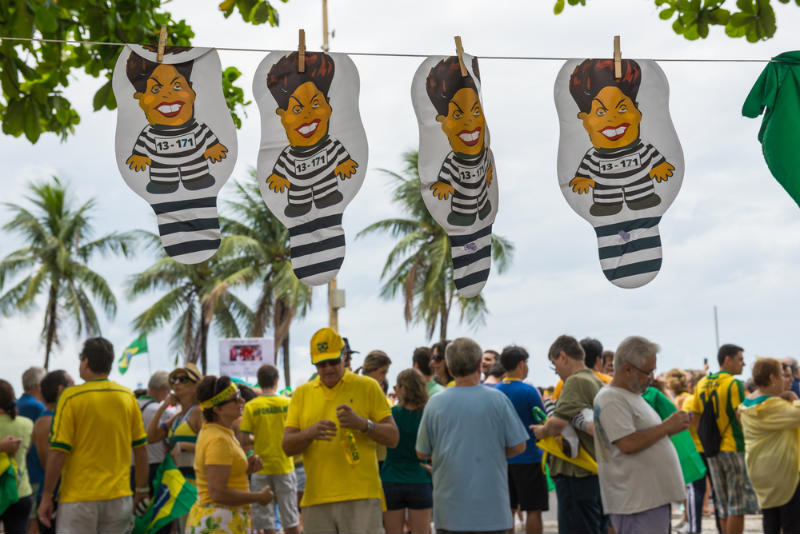How a woman who was never even elected for class representative became the president of one of the world’s largest economies—and why she was removed from power.
On January 1, 2007, the Dilma Rousseff project was set into motion. That was the inauguration day of Luiz Inácio Lula da Silva’s second term as the president of Brazil. His minister of justice, the late Márcio Thomaz Bastos—the Workers’ Party’s then-guru for legal matters and a man who enjoyed the absolute trust of Lula—informed Rousseff, who at the time served as the president’s chief of staff, of the “ambitious project” that their boss had in store for her. Rousseff’s first reaction was a big laugh.
She had her reasons for not believing it. She was not a leader within the Workers’ Party, having instead made her political career in the Democratic Labor Party and joined Lula’s political family less than 10 years prior. She was perceived as an impatient technocrat with zero charisma, and had never run for office. Up to that point, Rousseff had never been tested electorally, not even for class representative.
But Lula, the sun around which the Workers’ Party has turned, was facing a dilemma. The two men he was considering as possible successors had both fallen, one after the other, to corruption accusations. José Dirceu, his first chief of staff, had been impeached from his position as a representative after the prosecutor-general charged him for operating a bribing system in congress to assure the government would receive the votes it needed to pass certain pieces of legislation. Antonio Palocci, his first minister of finance, was accused of participating in clandestine meetings with lobbyists and prostitutes in a mansion in Brasília—and accessed confidential bank data of the mansion’s keeper—while heading Brazil’s economy.
To avoid an internal battle during his second term for the candidate nomination, Lula decided to appoint his heir on his own. Even though Lula was betting on an unknown political figure, his reasoning was something along the lines of this: If the economy goes well, his prestige would be enough to elect his successor. As he often is, Lula was right in his reading of the political conjecture of that moment. Brazil’s first president to have come from the working class would choose Brazil’s first female president. Talk about symbolism.
The First Term
In her first year as president, Dilma Rousseff was forced to change seven ministers due to corruption allegations, including her first chief of staff. After the press published cases of bribing demands from public officers, she started firing members of her cabinet, thus giving her the nickname of “Moral Cleaner.” Her approval ratings were never higher among voters, but among other politicians, her reputation started to sink.
Whenever these decisions were contested, she would offer the same response: “Have you had 55 million votes or have I?”
Rousseff wasn’t fond of the small gestures of “goodwill” so common in politics; she constantly refused to meet with party leaders and members of parliament who requested a word with the head of state. This is most obvious in the case of Senator Eduardo Suplicy, a Workers’ Party member, who sent her a grand total of 24 letters trying to request a meeting with the president to discuss his social welfare propositions. Suplicy represented more than 6 million voters in São Paulo, Brazil’s richest state. And yet in four years, she never met with him—and he was one of her allies.
She also infuriated congressmen because of her lack of will to authorize amendments to budgetary laws. In Brazil, every congressman has a small quota of the budget, often used to privilege their constituency, but the money needs the green light of the president to be used—and Rousseff would take her time in deciding whether or not it was a go.
As the president, Rousseff revealed her particular taste for micromanaging. She sponsored a project of surveillance cameras that allowed her to monitor federal projects in Brazil. From her cabinet, she started checking out the waiting lines in federal hospitals, even looking for leaks in public buildings.
She also revealed herself to be a hesitant decision maker. In 2013, she took six months to appoint a new Supreme Court justice after one of the court’s member retired. The same lack of urgency happened two years ago, when she waited 10 months to replace another justice. The omission was labeled by other members of Brazil’s highest court as “unreasonable” and “abusive,” as it left the court with an even number of judges, thus making it easier to have stalemates.
In terms of the economy, her presidency was a succession of errors. She insisted on placing Guido Mantega as finance minister despite having no credibility among economic actors. Meanwhile, she intervened constantly in the economy’s direction, forcing interest rates to go down and controlling both energy and oil prices. Rousseff also empowered two men who became notable for their fiscal “creativity”: former Secretary of the Treasury Arno Augustin and former Minister of Planning, Budget and Management Nelson Barbosa—who would become the architects of Brazil’s economic crisis. The government began to employ measures meant to mask a growing deficit, all in the name of reelection.
The 2014 Campaign
If Dilma Rousseff was already not a favorite among politicians, her reelection campaign marked the decisive moment when she burned all possible bridges. Her campaign heavily used the “us versus them” discourse, according to which her fellow contestants would cut social benefits and put austerity measures in place—not caring if Brazilians had food on their table or not. And the television ad war that followed between the opponents was really something.
She also wanted to sabotage the Brazilian Democratic Movement Party (PMDB), the party which was also on her presidential ballot with Vice President Michel Temer. Instead, her administration helped other intermediate parties to diminish the PMDB’s number of seats in congress. Like many of her political strategies, it didn’t work. The PMDB received the most house seats (13%) instead. Plus, with that strategy, the government created a sworn enemy with Eduardo Cunha, the man who would become house speaker and later set Rousseff’s impeachment in motion.
During her three months of campaigning, Dilma Rousseff insisted that the crisis was a reflection of the ailing international economy, stressing that everything was fine in Brazil, that no changes were necessary. Pessimistic citizens were simply cast as “antipatriotic.” In her victory speech, as well as in her inauguration speech, Rousseff did not even mention her opposing candidates. And right after securing four more years at the helm, she announced the name of a conservative minister of finance and planned to pass austerity measures.
But the government never shouldered the responsibility for taking those measures, instead allowing congress to take the blame for deciding on the harsh, and always unpopular, economic decisions. Thinking of their political future, congressmen started vetoing her proposals one after another. Not even her Workers’ Party backed her suggestions. The crisis was there for real, and she wasn’t able to approve what needed to be done.
The Implosion of the Dilma Administration
In 2013, the first demonstrations against corruption of public officers started to appear in Brazil. One of them finished with protesters seizing congress, throwing Molotov cocktails into the Foreign Affairs Ministry and threatening to take the Presidential Palace. Rousseff addressed the nation, promising a project meant to reform the political system—something that never went further than mere words.
With Operation Car Wash, public indignation started climbing to record levels. People were doing the math, saying to themselves: “We have terrible public service in Brazil, and politicians are syphoning money into their pockets.” And those things were not disconnected. Operation Car Wash investigations reached further and further into the corruption of publicly held companies, but Rousseff continued to live in denial. She was confident that nothing would get back to her office.
Politicians at the heart of her administration began to be targets of accusations, among them her campaign treasurer. But the government was always certain that, once the economy would get back on track, her approval ratings would return to positive levels. Another mistake.
But no strategic error was greater and more determining to her fate than her miscalculation of how to handle former House Speaker Eduardo Cunha. A man proven to be corrupt, Cunha is also extremely dangerous, controlling more than a hundred votes in the house—and occupying parliament’s most powerful position. He was the one who could ignite impeachment proceedings against the President.
The government had no means to destroy him, nor the means to seduce him. Until the very end, high-profile members of the Rousseff administration attempted negotiations with Cunha, but he remained determined to destroy her government and receive a pardon from the one that would follow. Once the impeachment was set in motion, Rousseff’s solution was to secure 172 votes—i.e. one-third of the house—to end the proceeding.
That process is the most telling of the president’s political ineptitude. On the eve of the April 17 impeachment vote in the house, Rousseff and Lula received congressmen at the presidential residence and tried to persuade them into refusing her removal from office. Some left offended by the fact that, after five years in office, she didn’t even know them by name.
One day later, the house overwhelmingly approved the continuation of Rousseff’s impeachment, with an astonishing 367 congressmen (out of 513) voting against her.
*[This article was originally published by plus55, a partner institution of Fair Observer.]
The views expressed in this article are the author’s own and do not necessarily reflect Fair Observer’s editorial policy.
Photo Credit: CP DC Press / Catarina Belova / Shutterstock.com
 We bring you perspectives from around the world. Help us to inform and educate. Your donation is tax-deductible. Join over 400 people to become a donor or you could choose to be a sponsor.
We bring you perspectives from around the world. Help us to inform and educate. Your donation is tax-deductible. Join over 400 people to become a donor or you could choose to be a sponsor.
Support Fair Observer
We rely on your support for our independence, diversity and quality.
For more than 10 years, Fair Observer has been free, fair and independent. No billionaire owns us, no advertisers control us. We are a reader-supported nonprofit. Unlike many other publications, we keep our content free for readers regardless of where they live or whether they can afford to pay. We have no paywalls and no ads.
In the post-truth era of fake news, echo chambers and filter bubbles, we publish a plurality of perspectives from around the world. Anyone can publish with us, but everyone goes through a rigorous editorial process. So, you get fact-checked, well-reasoned content instead of noise.
We publish 2,500+ voices from 90+ countries. We also conduct education and training programs
on subjects ranging from digital media and journalism to writing and critical thinking. This
doesn’t come cheap. Servers, editors, trainers and web developers cost
money.
Please consider supporting us on a regular basis as a recurring donor or a
sustaining member.
Will you support FO’s journalism?
We rely on your support for our independence, diversity and quality.







